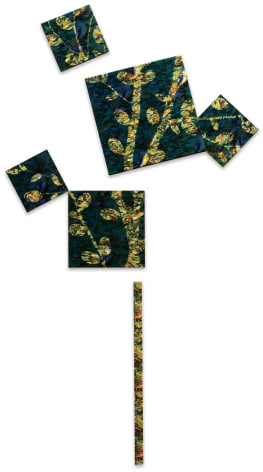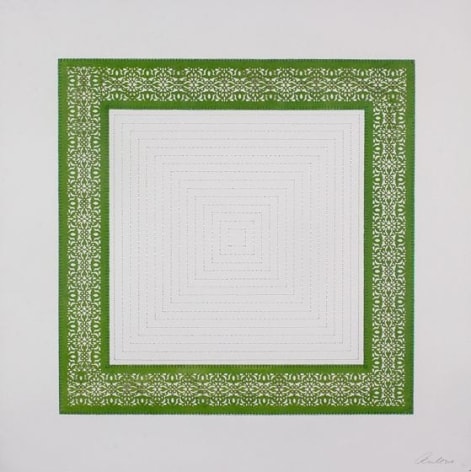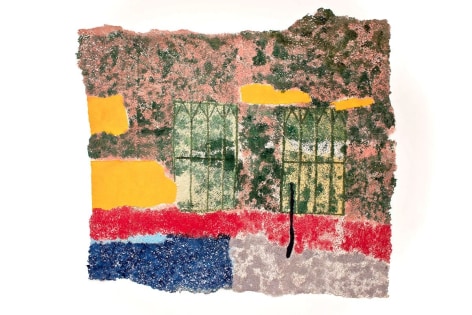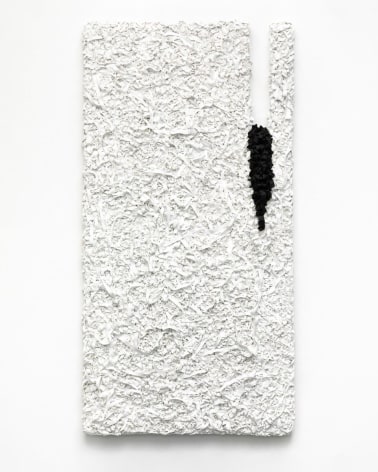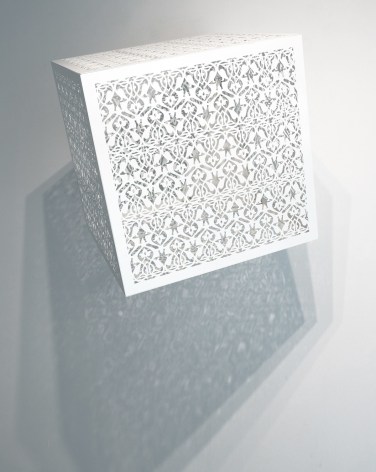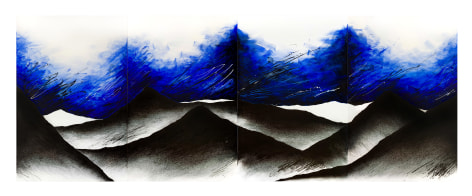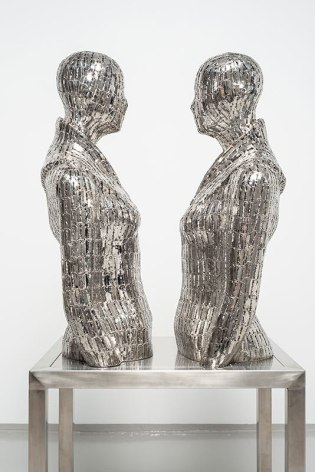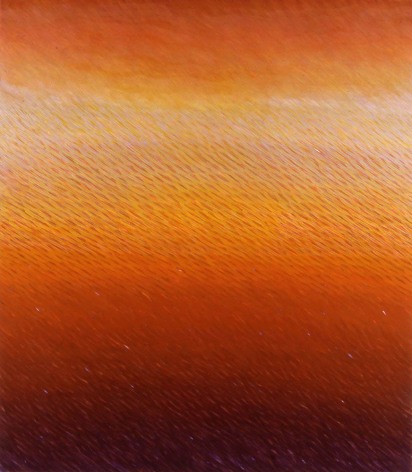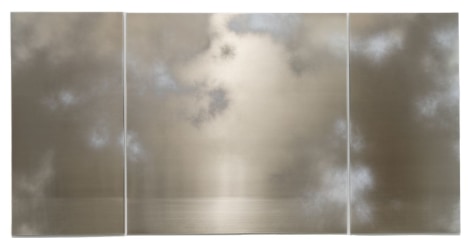We are pleased to present an exhibition of paintings and sculptures by eight gallery artists whose work explores, activates or reimagines spatial environments.
The qualities of the environments range from color-saturated landscapes on canvas to tactile abstract compositions that examine the interplay between paintings and wall surfaces. Presented together, the work demonstrates the varied ways in which artists engage with space to consider ideas of identity, gender, perception and place.
The Space Around Us reflects the gallery’s longstanding mission to highlight artists, particularly women and those from underrepresented cultures, whose work exemplifies our interconnectedness. The artists include Anila Quayyum Agha, Miya Ando, Golnaz Fathi, Jane Lee, Tayeba Begum Lipi, Neha Vedpathak, Joan Vennum and Susan Weil.
ANILA QUAYYUM AGHA
Anila Quayyum Agha (b. 1965, Lahore, Pakistan) is internationally recognized for her immersive large-scale cube installations that use light and pattern to create inclusive spaces. The patterns she laser cuts into lacquered-steel cubes are a reinterpretation of floral and geometric motifs found in Islamic art and architecture in Asia and Africa. When lit from within, the cubes cast elaborate shadows that transform the surrounding environment, alluding to the richly ornamented public spaces such as mosques that Agha was excluded from as a female growing up in Lahore. Agha, who is formally trained in textile design, also plays with light and shadow on a more intimate scale. Her intricately patterned drawings, which are hand-embroidered with reflective beads and metallic thread, pay homage to artists and craftspeople who historically have gone unrecognized.
Two of Agha’s large-scale light installations were recently on view at the Royal Botanic Gardens, Kew, and her embroidered drawings were the highlight of a 2022 solo show at the University of New Mexico Art Museum.
MIYA ANDO
New York-based artist Miya Ando (b. 1973, Los Angeles) has achieved critical acclaim for her paintings and installations that articulate transient aspects of the natural world. For Ando, who was raised between two vastly different worlds—a Buddhist temple in Japan and the redwood forest of northern California—the cyclical nature of clouds and other elements in the natural world serve as a metaphor for impermanence and interdependence.
Ando’s cloud works have been shown at the Smithsonian American Art Museum, Washington, DC; New York’s Noguchi Museum; and the Los Angeles County Museum of Art where her 2016 painting Kumo (Cloud) 6 was acquired for the museum’s permanent collection. The solo show of the artist’s work, Vespertine Clouds (Yūgumo) is on view through March 2, 2024, at Sundaram Tagore Singapore.
Golnaz Fathi (b. 1972, Tehran), whose work is in the collections of The Metropolitan Museum of Art, New York, and the British Museum, London, is renowned for her abstract paintings rooted in the rich traditions of Persian calligraphy. After becoming one of the country’s most skilled practitioners, Fathi left the privileged world of traditional calligraphy to pursue a career as a contemporary artist. Over time, she developed a distinctive style in which she transforms language into pure form.
In 2022, Fathi created a series of landscapes that center on the mountain ranges that surround Tehran, especially Mount Damavand, Iran’s highest peak. The mountains are entwined in Persian culture, holding a special place in myth and folklore, but to the artist, they are a symbol of resilience.
Jane Lee (b. 1963, Singapore) is known for her tactile, sensuous paintings, which are often dimensional enough to be considered wall-based sculptures. Through her work, she seeks to expand the possibilities of form and meaning in painting, often focusing on the relationship between a painting and the space it occupies. Rather than restricting herself to the physical limitations of a single canvas plane, Lee considers the total environment of an artwork. Walls are important to her—not just as a backdrop, but as an activating space.
In 2023, Lee was commissioned to create a series of interactive installations exploring space, light and reflection for an immersive solo exhibition at the Singapore Art Museum. A solo show of the artist’s work, Jane Lee: No Thing Is, opens March 14, 2024, at Sundaram Tagore New York.
Tayeba Begum Lipi (b. 1969, Gaibandha, Bangladesh) is a multidisciplinary artist known for her long-running sculpture series in which she uses fabricated razor blades to recreate experiences and objects from her daily life. The provocative choice of material is a reference to a tool commonly used in childbirth and to the violence some women experience in Bangladesh. For Lipi, it’s also a way to highlight life’s contradictions and invite the viewer to see more than just a bright, shiny surface.
In 2012, Love Bed, an early work from the razor-blade series, was included in the noted Guggenheim Museum survey of contemporary Southeast Asian art No Country and is now part of the museum’s permanent collection.
A native of New York, Joan Vennum (1930–2021) is known for her luminous paintings that portray the illusion of limitless space as it appears both in her imagination and in the natural world. Her lively compositions, articulated in layers of rhythmic brushstrokes and gradated color fields, are at once abstract and figurative. In her earlier explorations of light and space, Vennum painted subtle transitions of color forming veil-like surfaces. Over time, her handling of paint shifted toward a looser application and she introduced a more vivid palette reminiscent of Indian miniature paintings with concentrated vermilions, saffron yellows and indigos.
Vennum’s work is in the permanent collections of the Brooklyn Museum, New York and the Konstmuseet in Uttersberg, Sweden, among others.
Although she was active in New York during the height of the Abstract Expressionist movement, Susan Weil (b. 1930, New York) was never afraid to pursue figuration and reference reality, gaining inspiration from nature, literature, photographs and her personal history. Throughout her long career Weil has consistently brought to life intangible qualities of time and movement, creating multidimensional works in which she fractures the picture plane, deconstructing and reconstructing images. What results are dynamic and playful compositions that invite viewers to contemplate multiple perspectives at once.
Weil’s work is included in the collections of New York’s Metropolitan Museum of Art and Museum of Modern Art, and London’s V & A, among others.
NEHA VEDPATHAK
Since she moved to Detroit, Michigan, in 2016, Neha Vedpathak (b. 1982, India) often incorporates the forms and colors of the urban landscape that surrounds her into her abstract paper constructions. Using a rigorous technique she developed herself, which she refers to as “plucking,” Vedpathak spends hours separating fibers of handmade Japanese paper with a pushpin. There is a distinctly spiritual aspect to her slow and disciplined process, which she likens to meditative chanting tuned to a slower pace.
In 2022, the gallery placed one of Vedpathak’s architecturally inspired paintings, titled Those Places, in the United States Consulate in Hyderabad, India.

